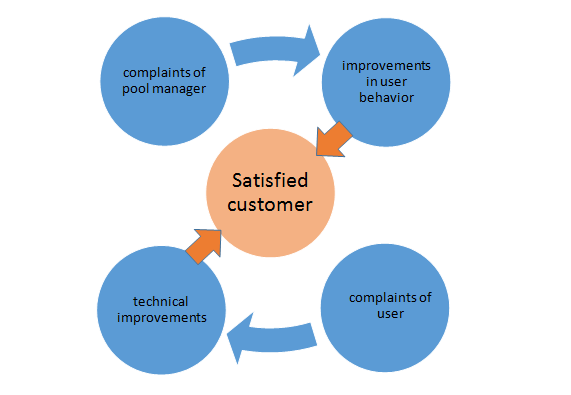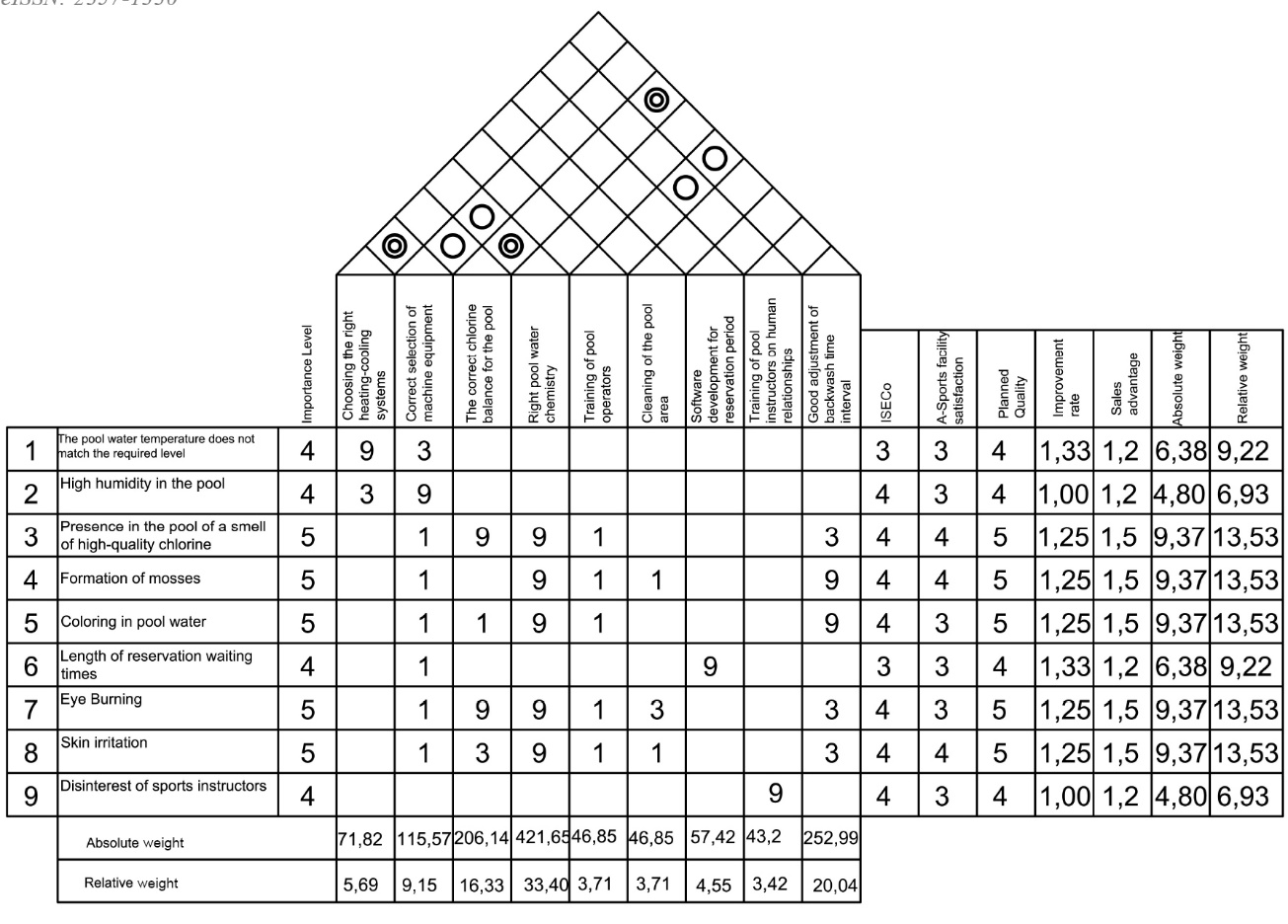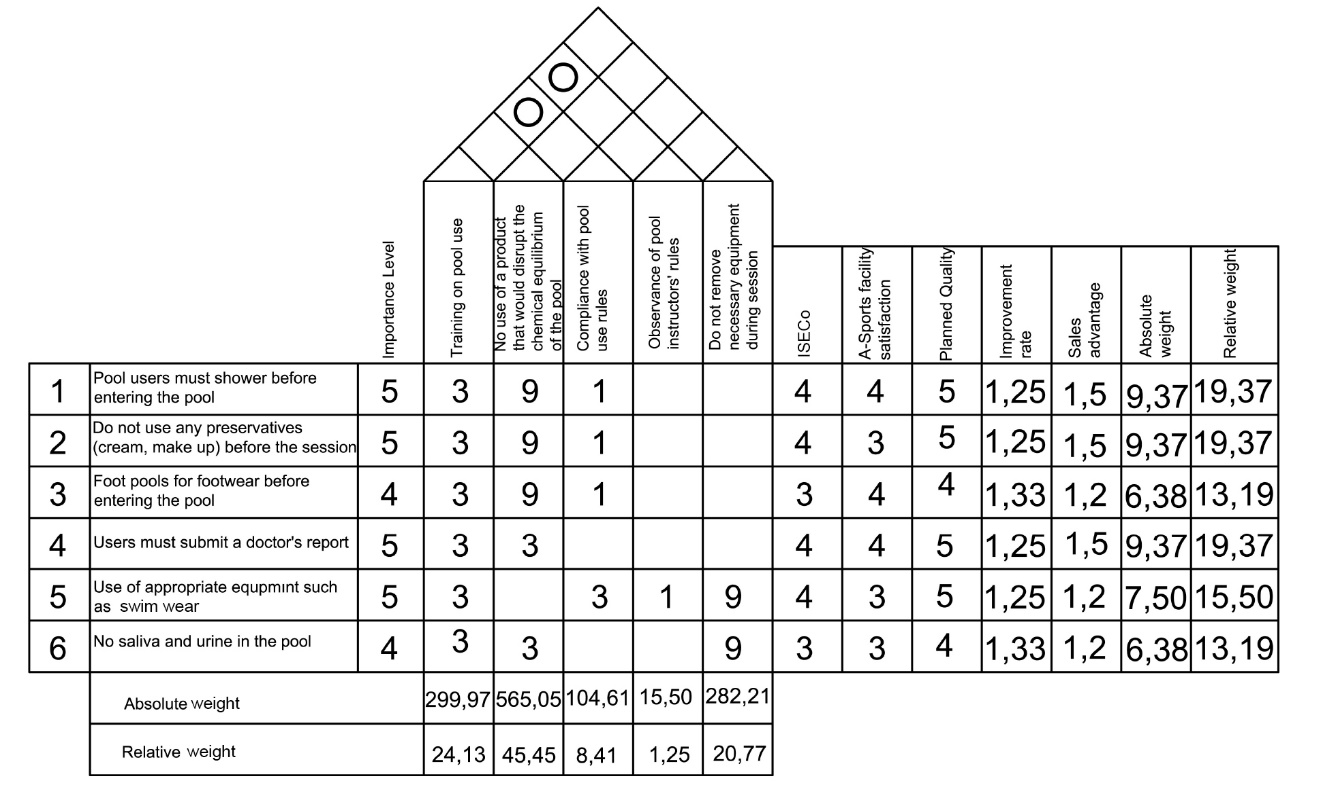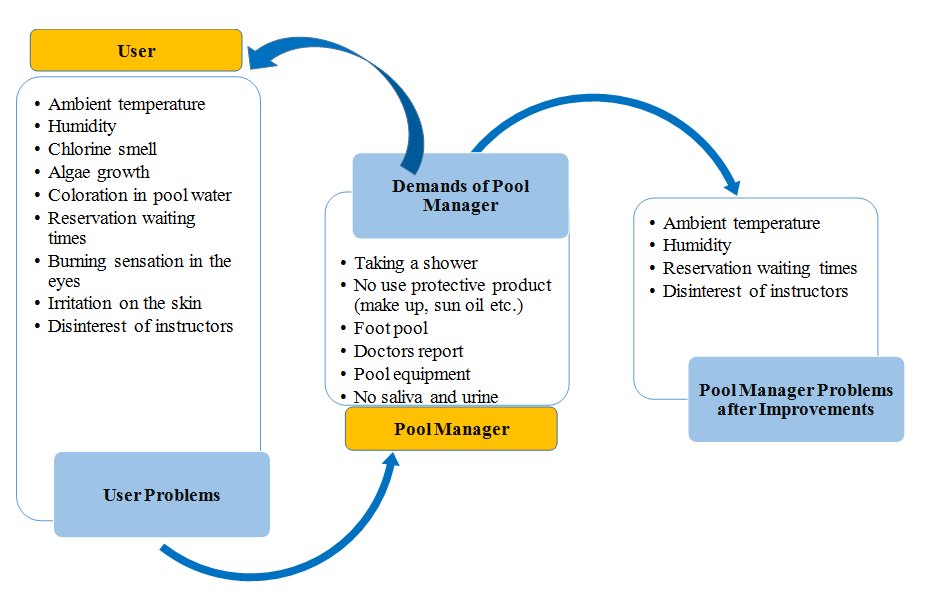Abstract
Swimming pool facilities are important organizations that provide service to users in all seasons, whether in the state or private sector, in terms of health and treatment as well as sports. It is extremely important that these facilities are user friendly in terms of hygiene and construction. It is the responsibility of the pool management to meet the expectations of the users of the facility, but the users have some responsibilities, such as complying with the conditions of use of the pool, not spoiling and not damaging the facility. A well-used and properly working facility will provide advantages over its competitors. Quality Function Deployment (QFD) is an important tool for strategic competitiveness. Using QFD, managers listen to the customer voice, translate to technical requirements, benchmark their competitors and design their products or services to the customer expectations. Hence, they have a chance for increasing their market share by the higher quality and customer satisfaction. Here the customer must be well-defined. In this paper, a different approach to the concept of customer is presented and QFD (cycle) is applied in swimming pools of Istanbul Metropolitan Municipality. It is assumed that the user and the pool manager are separate customers and it is aimed to increase service quality and customer satisfaction by listening to the voice of both customers. As a conclusion, the implementation of the QFD cycle has provided the necessary solutions, and most of the complaints have been removed.
Keywords: Quality Function DeploymentContinuous improvementCustomer satisfactionSwimming poolHealthcare
Introduction
From the point of view of health, swimming sports take an important place in the improvement of many diseases. Doctors advise patients to improve their bones, strengthen muscles, gain flexibility, improve heart health, asthma, weight control, cholesterol balancing, reduce diabetes risk, and improve blood circulation. It is ideal and necessary spore for pregnant, obesity, and autism. Besides, healthy people prefer to be healthy and vigorous, as well as swimming for spiritual refreshment and comfort. Swimming is a sport that increases body resistance as well as sleeping comfortably, walking away from the strut, exhausting, longer life and later aging.
It is natural that swimming pools are an educational place for those who want to practice swimming and learn swimming. However, in order to be able to take advantage of the vast majority of people in the public sector, the four seasons need to provide swimming pools and related facilities in almost every district in order to be able to play this sport. Local government has a great responsibility in this regard. Serving the public freely and / or at reasonable cost and establishing a widespread network of sports facilities is one of the key responsibilities of local governments.
It is also the duty and responsibility of the pool manager to observe the instructions for use of a pool, while the responsibility of the users is to provide the facility to the customer / user in a sanitary and planned manner that fulfills all operating conditions. In addition, it is an important responsibility of the pool managers to review the requests and complaints from the users and to make the principle of continuous improvement to be a lifestyle in order to serve them better. To summarize, if the facility management fulfills the customer's demands and complaints, and the customer fulfills the requirements, the customer will see that some of his complaints no longer arise, and mutual improvement will result in both the user and the pool manager.
In this paper, an introverted QFD study for the swimming pools in which the İstanbul Metropolitan Municipality (İMM), which has adopted the principle of customer satisfaction and continuous development, has been offered as a sports facility has been presented. Service delivery aimed at improvement with QFD is handled in customer- customer cycle and win-win application is clearly revealed.
Quality Function Deployment
QFD was used in the design of oil tankers at the shipyards of Mitsubishi in Kobe, Japan, in the late 1960s, is an approach that focuses on customer expectations and needs, also defined as the voice of the customer (Akao, 1997). The customers of the products or processes of the organization are both present and can be defined as a method that enables the conversion of customer voice to technical specifications so that it can meet the expectations and needs that may arise in the future. It is a methodology that places Customer Voice into product and service design (Gözlü and Birgün Barla, 2003). It is a planning tool that incorporates customer expectations of quality into every stage of product development (Govers 1996). The first step in the QFD is to set goals from the perspective of end users. The company should focus on customer expectations rather than thinking about what they want. It is not possible to spread the targets backwards, but to establish the quality houses chain.
Guinta and Praizler (1993) define QFD as "a logical way to determine how these needs will best be met with available resources, after listening to customers and learning exactly what they want." The goal of QFD is not only to meet customer expectations, but also to overcome these expectations. Each QFD team endeavors to make the designed product more attractive and attractive than the current product and products of competing companies. This includes features that the customer does not expect, but is likely to encounter, and they are used in the development phase of the product (Akao, 1990).
The basic planning tool used in QFD is the house of quality (Gonçalves et al.,2005). The house of quality (HoQ) translates the client's voice into design characteristics corresponding to the specific target values and determines how the establishment can meet them (Hauser and Clausing, 1988). Quality Function Deployment conveys the "customer's voice" in the company's most accurate way. In this way, the customer's desires and needs are given priority in the design of the product or service. After the customer's voice design is transferred, manufacturing, product presentation and service needs are also carried out in accordance with the needs and desires of the customers (Hassan et al, 2010). The product's pajama presentation takes place in a shorter time and the customers get the products they need in a shorter time.
Once HoQ has been established, the QFD study should not be considered complete. In a design activity, it is not sufficient to determine only the technical characteristics corresponding to customer requirements. It is also necessary to determine which parts, processes and production plan these technical characteristics can be realized and ensure that customer requests are transferred to each stage of design, development, production and service.
Sequential House-of-Quality
In this study; a QFD application is explained that has been performed with the aim to enhance customer satisfaction and improve service quality in the İstanbul Sport Events Co. (İSECo). İSECo is a department of İMM that conducts various activities such as İMM sport facility activities, sports activities in school sport centers, athletic training service, project of identifying future talents, sport activities for disabled people, help amateur sports clubs, training and cultural activities for sports and athletes, support for national and international sports organizations. There are 21 public swimming pools in İSECo which serve in each district. In the swimming pools, there are swimming lessons with instructors, trainings, various competitions such as water polo, swimming races are organized and services are provided to the public.
The managers of the pool, which are served for various purposes, aim to bring customer / user satisfaction to the highest level with the understanding of sustainable quality and give importance to the voice of the customer and aim at realizing their work within the understanding of continuous improvement. The demands, wishes and complaints of the customers are collected and evaluated continuously. The duties and responsibilities of the management are to ensure the correct operating and environment conditions, to treat the customer fluently and understanding, to provide and assist the customers to fulfill the instructions, and to make the necessary applications to bring higher quality of service. Therefore, it is natural for customers to have their customers' demands in order to provide quality service, which is in fact a requirement for customers to fulfill. Thus, management becomes the customer of the user. If this cycle runs properly, the complaints will diminish, in some cases it will be overcome and higher satisfaction and service quality will be expected.
In order to determine the solutions that will meet the expectations, the customer concept is expressed in two different ways and the customer's voice is listened and the HoQ is done sequentially. First, pool users were evaluated as customers and their demands and complaints were determined. The HoQ has been arranged and the solutions for these complaints have been introduced by the pool management. In the next step, customer is the service provider / the pool management, and has the complaints from the users. It is therefore necessary to listen to the voice of the service provider. Likewise, HoQs were arranged and solutions for service providers' requests and expectations were sought. Finally, it was determined that fulfillment of expectations of both types of customers was complaints that were completely lifted from the end, and user satisfaction was found to increase more than expected. The QFD cycle shown in Figure

Voice of the User
In the first stage, the complaints are listed as follows as a result of evaluating the forms that users of the pool have identified as the client placed in the complaint window:
• the pool water temperature does not match the required level
• there is no proper temperature in the pool
• high humidity in the pool
• presence of non-slip areas in the basin
• exceeding the maximum user capacity during pool sessions
• availability of corrosion-resistant building materials in the pool
• presence of a smell of chlorine of high quality in the pool
• burning problems in the eyes of the users of the pool
• irritation on the skin of the pool users, redness
• pouring on the hair of the users of the pool experiencing the coloring of bathing baths
• the amount of time to wait for a reservation to register a member of the pool
• fuzzy water
• coloring in pool water (green or brown)
• formation of mosses
• the chlorine content factors do not meet the standards
• foam in the pool water
• presence of colored particles in the pool water
• floors on the pool walls, thickening losses
• availability of corrosion-resistant materials in the pool metal
The HoQ prepared according to user complaints is given in Figure

In this step which is formed by going out from the way of many customers, the points which the customer complaints intensified are discussed. The priority given to the customer complaints is given as below according to their relative weights.
Too much chlorine smell in the pool environment (13,53%)
Occurrence of algae in the pool (% 13,53)
Colors formation in pool water (% 13,53)
Burning formation in the eyes of the pool users (13,53%)
Irritation in the eyes of the pool users (13,53%)
The customer complaints mentioned above have been observed as the most frequently complained complaints. Considering the importance of technical requirements that may be responsive to these customer requests, the first three are mentioned below;
Pool water chemical properties should be within the standards (33,40%)
Compliance with backwash time intervals (20.04%)
Pool chlorine balance compliance and regular control (16,33%)
When the above problems and technical needs are examined, it has been observed that the first priority in the formation of customer complaints sources is based on the pond water chemical properties. There are many factors that can compromise the chemical purity of the pond water. The technical requirement to observe the pond washing time intervals actually allows pool water chemistry to be located at the correct intervals. It is the sterilization process of pool water. Pool water chlorine balance is also one of the characteristics of the pool water chemistry. One of the most important tasks in these two falls to pool operators. In order to detect any problem in the pool water, the pool operators should carry out the test process by taking samples from the pool water at regular intervals.
It has been determined that the main problem in the HoQ created from customer complaints is that "Pool water chemistry is not in the correct intervals" as mentioned above. This problem has been seen as a result of the actual work that is caused by the problems caused by misuse of the pool by the customers. It is possible for pool users to leave their main complaints in case of completing the pool use rules. It has been determined that the user will have to shower before entering the swimming pool that the pool operator desires, and that many problems will automatically disappear if the rules are followed, such as not to use any preservative (cosmetic product) prior to the pool use.
The following explanations are given to understand which components are present in the pool water chemistry and which balances are corrupted in the pool water as a result of improper handling (Savaş, 2010; Erkoç, 2017);
PH; The proper pH value of a pool is 7.4.
Total Alkalinity (TAC): TAC can be defined as the resistance of water to pH change. The total alkalinity value of a pond is in the range of 80-120ppm.
Total dissolved solids (TDS): The sum of all solutes dissolved in water. The ideal TDS to be found in a pool is 1000ppm.
Total Hardness: Quantitative measurement of dissolved calcium and magnesium ions in water. The ideal hardness value in a pool is around 200-300 pmm. As long as the values of the above mentioned components are in accordance with these standards, there is no deterioration of the pool chemistry. If the pool is balanced, there are no problems.
Voice of the Pool Manager
In this step, the pool manager is defined as the customer and the HoQ constructed according to what the pool manager wants from the customer is shown in Figure

Prior to the use of the pool, users must submit a doctor's report that does not mind hepatitis A, complete urine testing and sports; they must use a bonnet during the session, do not use any preservatives (suntan lotion, cream, make-up products ..) before the session and enter the foot pools for footwear before entering the pool.
From the Figure
• Indoor pool users must shower before entering the pool (19,37)
• Indoor pool users should not use any protective cream or cosmetic before entering the pool (19,37)
• Obtaining a doctor's report indicating that there is no health problem related to pool use (19,37).
In the technical answers developed for the requests of the facility operators, the technical requirement that should be given the highest priority was 45.45% '' no use of a product that would disrupt the chemical equilibrium of the pool ''. According to the result of the HoQ, if the chemical which should be given priority should not be used any preservative material, the appropriate water level of the pool will not deteriorate. The water balance, which is seen as the main source of many problems, is very uncomfortable. Many problems are caused by the deterioration of any material in the water balance (PH balance, free chlorine ratios, bound chlorine ratios, ions in the pool, etc.).
According to the results of two houses of quality consisting of the voice of the user's and the pool managers; the complaints from the customers and the requests of the pool managers as seen in the HoQs that have been established have been formed as a whole. It has been seen that customer complaints will also decrease when the pool managers meet their demands. The complaints of both sides need to be considered as a whole.
Satisfied Customer
If the users correct the behaviors complained by the pool managers, it is determined that the user complaints stated in the HoQ will be canceled. The technical problems detected by managers other than the user will be automatically lifted in the meantime. This will reduce the workload required to be done.
It has been observed that the main cause of the problem in both of the complaints from user complaints and in the HoQs developed by the pool managers according to the requests of the users depends on the chemical properties of the pool water. If the users comply with the plant managers' demands, the degradation of the pool water chemistry will be minimized. Likewise, complaints from user complaints have been observed to be the main cause of the deterioration of the pool water chemistry. In order to minimize the user complaints, pool operators must regularly perform necessary maintenance and checks of the water, providing water balance in response to deterioration of the pool chemistry.
As it is seen from the studies, the most important issue for the complaints of the users and the managers is the chemical equilibrium of the pool. It is the main cause of many complaints. Customer complaints will be reduced accordingly if the user correctly meets what the plant operators want for the use of the pool. In the same way, if the managers take the pool complaints as a priority and carry out studies to resolve them, the user complaints will be reduced in parallel. Figure

As seen above, customer problems and operator requests are concepts that will not be considered separately. Customers will automatically experience a reduction in complaints that they see as problems when they do what they want. The remaining customer complaints will need to be solved by the pool managers in the technical needs they have developed within the facility. The most important detail here is how much of the remaining customer problems are reduced as a result of corrections. Pool managers will have great advantages in terms of time, cost, etc., by concentrating on remaining customer problems instead of searching for a lot of probing techniques. As a result, the workload of pool managers will be greatly reduced.
Conclusion and Discussions
It depends on knowing who the customer is. In the buyer-seller relationship, it is generally accepted as the buyer's customer but the seller will also be in demand and the relationship is mutual. In the win-win approach, both sides must be on the side of satisfying each other. If this is a manufacturing company, the seller has to deliver the product to the buyer at the desired quality and quantity and at the right place at the right time, and the buyer has to present the seller at the time and at the price he promises. Or they must make their order on a regular basis and notify the changes within a reasonable time. However, if the buyer is satisfied with the seller and the seller is satisfied with the buyer, a long-lasting and high-quality relationship can be achieved. When one-sided satisfaction needs to leave the other party in a difficult situation, it can not be expected that the lifetime of this relationship is long. This situation is also the same for the service sector. Providing a good service does not just depend on pool management. It is management's responsibility to ensure that rules are applied without hurting the user. However, the user is obliged to comply with these rules. As with a Turkish proverb, with the "
This study was conducted to increase customer satisfaction in IMM, which has thousands of swimming pools operated by people. Users from different pools benefit from 21 pools at different levels of culture and education. It is obvious that in order to make the usage instructions more interesting in the high and middle social level, it is obvious that users should be educated in seminars, lectures and conferences.
Acknowledgments
The authors would like to thank the Directoriate of Youth and Sports of İstanbul Metropolitan Municipality for their valuable support to our study.
References
- Akao, Y. (editor in chief), (1990), “Quality Function Deployment”, Productivity Press, Cambridge, Massachusetts.
- Akao, Y. (1997). QFD: Past, present, and future, International Symposium on QFD'97, Linköping pp.1-12.
- Erkoç, E., (2017). Türk Standartları Enstitüsü TS 11899 Yüzme havuzu suyunun hazırlanması, Teknik Yapım, Kontrol, Bakım ve İşletmesi İçin Genel Kurullar, http://www.uhe.org.tr/tse.html .
- Gonçalves-Coelho,A.M., Mourao A.J. F. & Pereira, Z.L. (2005). I mproving the use of QFD with Axiomatic Design, Concurrent Engineering, 13 (3), pp.233-239.
- Govers, C.P.M. (1996). What and how about Quality Function Deployment (QFD), International Journal of Production Economics, 46-47, 575-585.
- Gözlü, S. & Birgün Barla, S. (2003). Evaluation of suppliers utilising Quality Function Deployment: A case study, "One World? One View of OM?" The Challenges of Integrating Research&Practice, Editors: Gianluca Spina, Andrea Vinelli, Raffaella Cagliano, Matteo Kalchschmidt, Pietro Romano, Fabrizio Salvador, Vol. II, 443-449, Cernobbio, Lake Como, June 16th-18th 2003-ITALY, ISBN 88-86281-78-1.
- Guinta, L.R & Praizler, N.C (1993). The QFD Book: The team approach to solving problems and satisfying customers through Quality Function Deployment, Amacom, New York, N.Y.
- Hassan, A., Siadat A., Dantan J.Y., & Martin, P. (2010). Conceptual process planning – an improvement approach using QFD, FMEA, and ABC methods, Robotics and Computer-Integrated Manufacturing 26, 392–401.
- Hauser, J.R. & Clausing, D. (1988). The House of Quality Harvard Businee Review, May-June, 1988, 1-13.
- Savaş, B., (2010), Havuz Operatörleri Eğitimi, Ders Notları, Ataşehir Halk Eğitim Merkezi, Mayıs 2010.
Copyright information

This work is licensed under a Creative Commons Attribution-NonCommercial-NoDerivatives 4.0 International License.
About this article
Publication Date
20 December 2017
Article Doi
eBook ISBN
978-1-80296-033-4
Publisher
Future Academy
Volume
34
Print ISBN (optional)
--
Edition Number
1st Edition
Pages
1-442
Subjects
Business, business studies, innovation
Cite this article as:
Birgün, S., & Çalışkan, Y. (2017). Who Is Customer? : A QFD Cycle For The Swimming Pool Managers. In M. Özşahin (Ed.), Strategic Management of Corporate Sustainability, Social Responsibility and Innovativeness, vol 34. European Proceedings of Social and Behavioural Sciences (pp. 103-112). Future Academy. https://doi.org/10.15405/epsbs.2017.12.02.9

